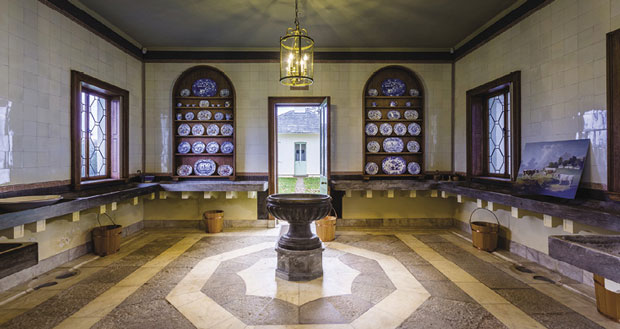The installation of technology which enables the live real-time monitoring of an historic building could revolutionise how we protect and preserve heritage sites finds Sara Bean
During the pandemic one of the most longed for aspects of normal life has been the opportunity to visit museums, stately homes and other heritage sites. Whether they’re open or closed to the public, preserving these buildings and their contents from damage is a key concern. Take for example the devastation caused by a fire at Surrey’s Clandon Park in 2015, which destroyed the stately home and a great deal of its collection of artefacts and interiors.
Innovations which help to preserve and protect precious buildings and their contents are incredibly important. This is why it is reassuring to hear that of the extension of a major pilot scheme to monitor and manage building services by Ecclesiastical Insurance and English Heritage, in partnership with technology firm Shepherd, has put Grade I listed Kenwood House on a technological par with The Shard.
Kenwood House, set on the edge of London’s Hampstead Heath, dates back to the early 18th century, where between 1764 and 1779 Robert Adam transformed it into a neoclassical villa for William Murray, 1st Earl of Mansfield. Its interiors include some of Adam’s finest surviving schemes and the house is now home to the 1st Earl of Iveagh’s renowned collection of Old Master and British paintings, which includes works by Rembrandt and Vermeer.
Nicholas Hartley is Head of Business Improvement and Innovation for Ecclesiastical, a specialist insurer of the faith, heritage, fine art, charities, education and private client sectors: “One of the challenges of heritage buildings compared to new builds is that old buildings like Kenwood often predate electricity, running water and gas, so everything is retrofitted. Also, a modern visitor attraction with multiple floors requires the installation of a lift which means lift shafts and voids which can then present added risks. This is why it is crucial that we mitigate risk as best we can to reduce the potential of a fire. Water is also a very significant issue, because even a small leak can have a bad effect, and it might happen over a long time without being noticed.
“Ecclesiastical has a loss prevention innovation programme which has a number of objectives, one of which is finding innovative ways of addressing common risks for our customers and how to reduce the level of disruption and loss. The initiatives used within that programme, include drones, thermography, as well as data driven approaches and IoT sensors but primarily in the home environment.
“The work with English Heritage came about because it is a long-standing Ecclesiastical customer and we’ve good relationships with them so it felt like a natural progression to propose that we work in partnership with Shepherd.”
REAL TIME MONITORING
The project involved installing dozens of sensors, which are unobtrusive, battery-operated and do not require Wi-Fi, inside Kenwood House to discreetly monitor environmental changes within the building. The sensors deployed in the estate then send live real-time data back to be analysed.
Says English Heritage’s Senior Estates Manager, Nicola Duncan-Finn: “While similar monitoring services are often installed in modern buildings, this is the first time this technology has been piloted within an 18th-century heritage property of this scale, complexity and national significance.
“The sensors don’t rely on Wi-Fi and can cope with thick walls. Long battery life means they’ll continue to function during power cuts – an incident they’ll actually help to monitor – along with boiler breakdowns, electrical fires and water leaks. They’ll alert our estates team to any critical issues as soon as they emerge – helping us protect the house and its collection in the event of an emergency.”
“These sensors capture data on environmental factors like temperature and humidity, which is critical when it comes to conserving our collections. Real time monitoring will give us even more information when it comes to prioritising our preventative maintenance programme. For instance, we’re now able to identify performance issues in our mechanical and electrical plant or catch minor leaks before they cause major problems.”
Retrofitting sensors within older buildings is Shepherd’s business model and they’re working closely with Ecclesiastical to help reduce the number of claims while also providing additional services to clients in terms of energy reduction. The sensors are designed to co-habit seamlessly with any existing building management and environmental monitoring systems.
According to Stephen Chadwick CEO of Shepherd: “The sensors aren’t even the clever bit, they’re just a way to send live real-time data back to the Shepherd hub to be analysed.
“The Shepherd hub is an analytics engine which turns raw data into knowledge, achieved by layering data and enabling us to analyse new subsets to look for different problems. All of that is represented on the Shepherd hub as information, and that information contextualised for a particular building creates new knowledge and knowhow that is fed back to the onsite engineering and management team; and back to Ecclesiastical.
“Because the BMS is only as good as when it was installed, our process is to extract as much data as we can, which provides a gap analysis on the assets being monitored. In Kenwood there was also a humidity monitoring system, so we were able to utilise that, and filled in the gaps with the monitoring equipment.
“It’s the same as with any office building or heritage site, in that we work in that structured way to understand the architecture, position the sensors that need to be utilised on top of what is already available, which results in full building coverage.”









